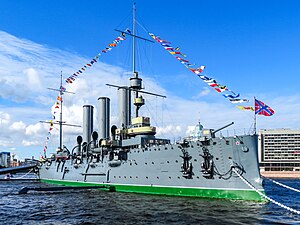 Aurora, moored in Saint Petersburg, Russia, July 2022
| |
| History | |
|---|---|
Russian Empire → Soviet Union → Russia | |
| Name | Aurora |
| Namesake | Aurora (mythology) |
| Ordered | June 1896 |
| Builder | Admiralty Shipyard, Saint Petersburg |
| Laid down | 23 May 1897 |
| Launched | 11 May 1900[1] |
| Completed | 10 July 1903 |
| Commissioned | 16 July 1903 |
| Decommissioned | 17 November 1948 |
| Honours and awards | |
| Fate | Museum ship since 1956 |
| Status | Ceremoniously commissioned |
| Notes |
|
| General characteristics | |
| Class and type | Pallada-class protected cruiser |
| Displacement | 6,731 t (6,625 long tons) |
| Length | 126.8 m (416 ft 0 in) |
| Beam | 16.8 m (55 ft 1 in) |
| Draught | 7.3 m (23 ft 11 in) |
| Installed power |
|
| Propulsion | 3 shafts; 3 triple-expansion steam engines |
| Speed | 19 knots (35 km/h; 22 mph) |
| Range | 7,200 km (4,500 mi) at 10 knots (19 km/h; 12 mph) |
| Complement | 590[2] |
| Armament |
|
Aurora (Russian: Авро́ра, romanized: Avrora, IPA: [ɐˈvrorə]) is a Russian protected cruiser, currently preserved as a museum ship in Saint Petersburg. Aurora was one of three Pallada-class cruisers, built in Saint Petersburg for service in the Pacific. All three ships of this class served during the Russo-Japanese War. Aurora survived the Battle of Tsushima and was interned under US protection in the Philippines, and eventually returned to the Baltic Fleet. One of the first incidents of the October Revolution in Russia took place on the cruiser Aurora, which reportedly fired the first shot, signalling the beginning of the attack on the Winter Palace.
- ^ "History". The Cruiser Aurora. Retrieved 5 June 2021.
- ^ "General information". The Cruiser Aurora. Retrieved 5 June 2021.
- ^ Polenov, L.L. (1987). Крейсер "Аврора" [Cruiser "Aurora"] (in Russian). Leningrad: Судостроение. pp. 162–165.